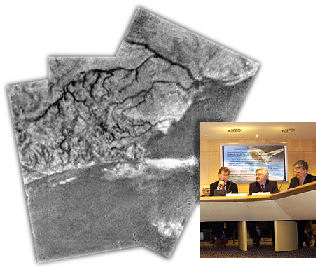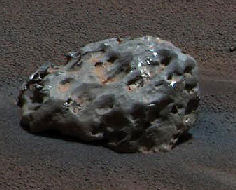Friday, January 21, 2005
At 1.2 billion miles from war-torn and soon to be Bush-dominated Earth there’s a chance of partly cloudy skies and occasional showers on the super cold exotic surface of the Saturnian moon Titan.

ESA Scientists describe Titan's exotic environment
The first scientific assessment of data from the Huygens probe, including previously missing information recovered through American and European radio-telescopes monitoring the probe’s telemetry, was made at the European Space Agency Headquarters this morning in Paris, France.
Dr Martin Tomasko, Principal Investigator for the Descent Imager-Spectral Radiometer (DISR), said:
"Geological evidence for precipitation, erosion, mechanical abrasion and other fluvial (pertaining to rivers) activity says that the physical processes shaping Titan are much the same as those shaping Earth.”
Though Titan’s river and lakebeds appear dry at the moment, Huygens provided strong evidence of recent liquid methane rainfall.
Scientists reported the Gas Chromatograph and Mass Spectrometer (GCMS) and Surface Science Package (SSP) both detected methane evaporating from the landing area “soil” following contact with the atmospherically warmed skin of the Huygens probe thus further reinforcing the organic compound’s primary role in the moon’s geology and atmospheric meteorology.
Spectral measurements of the small “rocks” visible in the probe’s pictures of the Titanian surface are, according to the ESA scientists, “consistent with a composition of dirty water ice rather than silicate rocks.”
At Titan’s –170 degrees Celsius (-274 degrees Fahrenheit) surface temperature methane exists as liquid and gas while water ice exists in a form as solid as an earth-bound rock.
Many of our Earth’s familiar geophysical processes, according to the Huygens' data, have an exotically different chemistry within the alien Titanian environment:
Instead of liquid water, Titan has liquid methane. Instead of silicate rocks, Titan has frozen water ice. Instead of dirt, Titan has hydrocarbon particles settling out of the atmosphere, and instead of lava, Titanian volcanoes spew very cold ice.
Scientists speculate that Titan’s methane rainfall may be seasonal and, according to the BBC, indicated a desire to send robotic explorers, similar to the Mars Rovers, to further explore this unusual new world.
Mars Meteorite Update

NASA has posted this color image of “the first meteorite of any type ever identified on another planet.”
According to Opportunity’s spectrometers, the “pitted, basketball-sized object” is made of iron and nickel.
NOTE
I've dashed off an email to Google AdSense about the recent flood of pro Bush advertising atop this page.
Since most of you ignore these ads I don't find them terribly troubling except to realize that some sticky-fingered Rethug loyalist went to a bit of trouble evading Google's filtering process to occasionally stick the President simian visage atop this humble blog.
Actually, I'm taking it as a, sort of, strange compliment.
Photos: ESA, NASA/JPL

